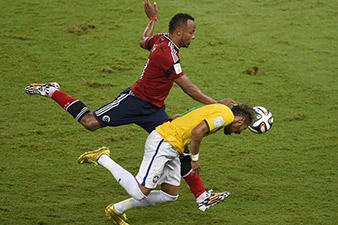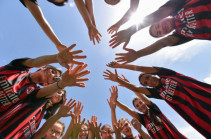
21/07/2014 11:52
After Theater in Brazil, Soccer’s Calloused Cousin Takes the Stage
N.F.L. training camps open this week. With that summer ritual, the eagerly awaited heathen season is upon us. N.F.L. football is back.
For casual soccer fans, the World Cup was an intriguing spaceholder. Great theater. In fact, soccer offers much better theater than the N.F.L.
Broadway on the pitch.
At seemingly every point of contact, some player takes a dive, rolls around, grabs a knee or an ankle, grimaces as if in excruciating agony. The next minute, the same player is up and running full tilt.
I get it. This is the theater of the beautiful game.
There are instances in American football when players feign an injury to stop the clock. By and large, however, when a football player is facedown on the turf or writhing in agony, the pain is real and the injury is authentic: a cracked rib, a broken kneecap, a torn muscle, a concussion.
During these high-profile soccer cavalcades, we make a habit of offering suggestions about what needs to be done so the sport can get a psychological stranglehold in the United States. I don’t have any suggestions about that, but I had an epiphany during the match between Colombia and Brazil when Colombia’s Juan Camilo Zúñiga violently hit the Brazilian star Neymar in the back. Neymar missed the remainder of the World Cup with a cracked vertebra.
My immediate thought after watching the play — again and again and again — was “Now that’s what soccer needs more of” if it wants to occupy a larger space on our palette. Big hits and midair collisions. We like collisions; we like the violence.
Cynical, but true.
During the past two years, I have spoken with, or heard from, friends and countless fans who admit to being terribly conflicted about their passion for football.
They have read the studies, followed the various trials. They know about concussions, head trauma and the cumulative effects of collisions. They feel bad about the former players who have long-term disabilities.
On the other hand, they cannot wait for the opening of a new season, that first kickoff and the first jarring tackle.
I tested my theory on Don Cogsville, who was on the University of North Carolina soccer team from 1984 to 1988 and was one of the first black players to join the United States national soccer team, in 1988. He also played professionally in the Major Indoor Soccer League for a season.
Cogsville said soccer would not have to become more violent to appeal to our rough-and-tumble sensibilities.
“At the end of the day, I discount that,” he said. “I discount that and say that, ultimately, we’re going to fall in love with the game as it’s supposed to be played, and those bloody moments will start to be less needed to get someone’s attention.”
Cogsville spent one season in the M.I.S.L. and saw how a contrived version of the sport did not work.
“The M.I.S.L. moved indoor to try to appeal to the perceived American appetite,” he said. “It was about fast moving, off the board, hard hitting, high scoring.
“It didn’t work because it was unauthentic,” he said. “In trying to appeal to that other interest, the game became less flowing. So we can’t chase our tail. This game is beloved around the world, so we’ll move with that, and I think the American public is going to move with it, too, and start getting used to what the game is really about.”
Cogsville said that soccer, in order to grow in the United States, needed characters and outrageous actors like Italy’s Mario Balotelli or Uruguay’s Luis Suárez. Balotelli is known for his unpredictability and exuberance. Suárez bit an opponent during a World Cup game. That didn’t stop Barcelona from signing him to a lucrative five-year contract.
“Soccer has lots of characters around the world,” Cogsville said. “In this country, the effort has to be to make it less humongous and more reflective of the melting pot.”
That brings us — once again — to a fundamental challenge facing soccer in the United States. For the sport to expand, it must find a way to exploit the United States’ enormous pool of athletic talent. This is not a new challenge but remains one of the crucial impediments to the United States’ becoming a feared force in World Cup soccer.
Elite soccer in the United States at the youth level continues, for the most part, to be pay-to-play. This alone creates a barrier to broad-based access and widespread appeal.
Some critics have called soccer in the United States a country-club sport played in suburbia with limited access to socioeconomic-challenged sectors of society. Some have even said this is by design.
“I don’t know that there has ever been intentionality around making this any kind of elite sport,” Cogsville said. “The problem has been there may not have been the right people, or solutions, trying to figure out how to solve the problem.”
Irv Smalls is the executive director of F.C. Harlem, a youth soccer program that uses the game to help save, and shape, the lives of young people in the community. Smalls is looking to build an indoor, Harlem-based facility than can be used throughout the year. He contends, and I agree, that governing organizations must help establish and support youth leagues in economically disadvantaged communities. These leagues must become part of the social fabric of the community where potential players live.
As Smalls once told me in an interview, “It has to be a grass-roots initiative, and the movement has to come from the inner city.”
Soccer continues to sink deep roots in the United States. The enthusiasm we witnessed during the past month will be sustained.
“I think football and baseball are concerned,” Cogsville said, referring to the World Cup success. “You can’t ignore what you’ve just seen. The sport may not be there now, but it’s on a steady march to probably be one of the top sports in the country.”
No doubt.
But for now, and for reasons that probably reflect poorly on our collective psyche, football has a powerful grip on our pleasure center. The vicious, but familiar-looking, hit on Neymar reminds us why.
Helmets. Face masks. Shoulder pads. Linebackers delivering bone-crushing hits.
Say farewell to the World Cup and raise the curtain on the N.F.L.
Let the heathen season begin.








